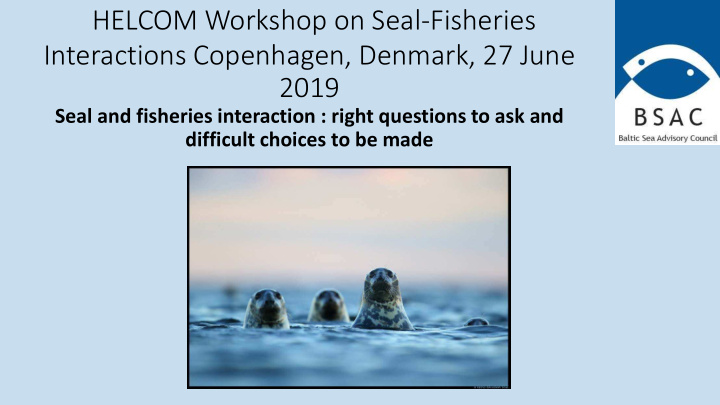



HELCOM Workshop on Seal-Fisheries Interactions Copenhagen, Denmark, 27 June 2019 Seal and fisheries interaction : right questions to ask and difficult choices to be made
Th The c con onflict between s seals ls an and fisher eries es i is old and w world-wide Photo by M. Daniluk
Some conclusions from the BSAC – more questions than answers • The BSAC can’t agree on a concerted way forward, views are diverse • We need an ecosystem approach to solve the problem between seals and fisheries • What is a Good Environmental Status with respect to an acceptable level of seals? • Currently very hard for fisheries to co-exist with seals in some areas • How and in what way should seals be managed? • Is there enough funding to monitor the seal population? • Difficult choices that should be based on science: Member States and EU bodies must act
We We need eed to ask the r right ques estion ons - what is it that managers really want to achieve? Discussions must be separated to find the right questions to ask to the right people: • The fishery problem • The biodiversity problem • The ecosystem problem
Fis ishery ry • A very real and difficult problem • A technical issue • An economic issue of lost fish, extra work and damaged gears • Partly a socio-psychological issue and not natural science issue
Biod odiversi sity ty • Seal population status unevenly distributed • Grey seal is the issue, what about other seals? • Migration patterns and consumption • Behavioral changes and health of seals • Are seals in good status or not?
Ec Ecosys ystem • Predation – natural mortality • Spreading of parasites (also M) • Driver on fish stocks, other species or not? • Other impacts on the marine ecosystem drives a change in seal behavior? • Other ecosystem impacts/changes that may mask effects?
What s should H HELCOM a address? • Seal status and reference levels • Risks to the species in current situation • Changed recommendations on supporting seals? • Effects on ecosystem or because of changed ecosystem?: Consumption is a marine mammal “people” question (diet, when, what , where) Impact on fish is a ”fish people” question (drivers of stock dynamics) Questions related to changed feeding patterns, other species changes etc?? Reminder: consumption is not the same as impact
UN UNEP Protocol f l for or th the s sci cien entific ific evalu luatio ion of of p proposals ls to cull marin ine mamma mals Was first considered in 1992 due to intensified debate on interactions. The SAC was given two tasks: compile a list of historical and current culling programmes and situations in • which proposals have been made for culls for the intended benefit of fisheries resources, and draw up guidelines for the scientific evaluation of culling proposals, • including a specification of the information which is needed to evaluate a cull proposal.
UN UNEP Prot otoc ocol f for t the s scien enti tific e evaluati tion on o of p prop opos osals to cull marin ine mamma mals Basic information needed: • the marine mammal population, range and migration • the target fish species, the fisheries involved • the geographical area of concern Cull objectives: • Biological (to increase abundance of a stock) • Operational (realized catch rates by certain fisheries) • Economic (improve profitability of a fishery)
UN UNEP Prot otoc ocol f for t the s scien enti tific e evaluati tion on o of p prop opos osals to cull marin ine mamma mals Culling programme • envisaged duration • annual numbers to be killed or details of other measures, e.g. bounties • measures to estimate the numbers killed • target population size or other reduction/control targets, if any • provisions for monitoring marine mammal population • provisions, for monitoring the effects of the cull. Costs of a cull can be substantial. Who will pay if not proven to work?
Thank you ou and let et us us sta tart finding the r right ht questions and answer ers
Recommend
More recommend